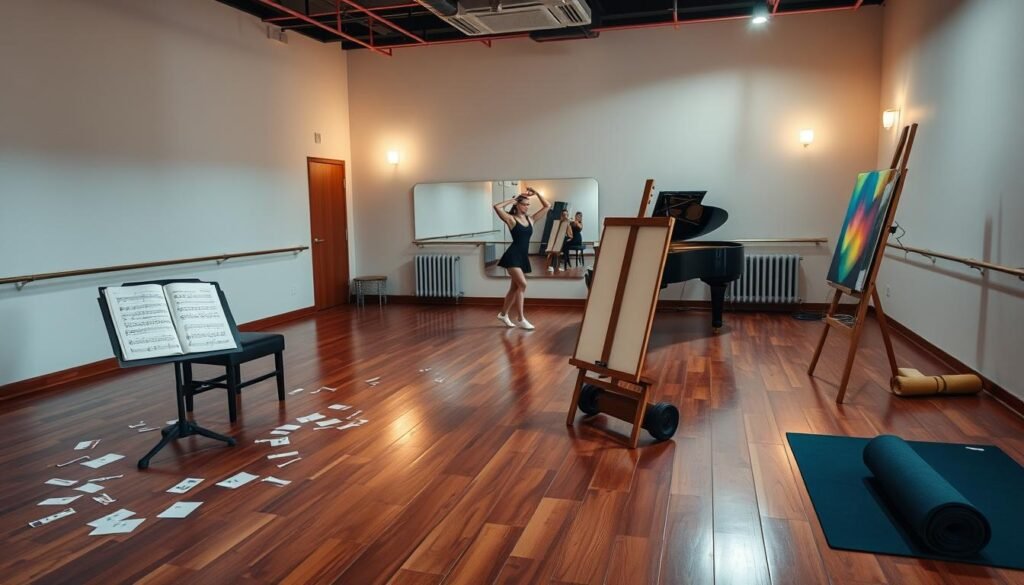About 75% of people feel nervous when they have to speak in public. Think about it, that’s most of us! It’s not just about talking to a crowd. Athletes and performers get stage fright too. When the pressure is on, it can be tough to show what you’re really capable of. But if you learn how to deal with performance anxiety, you can really shine.
We’re going to look at some real steps you can take to feel less anxious. Finding out why you’re nervous is a good start. Then, getting ready in the best way possible is key. These tips will help you get ready to do your best. By working on both your mind and body, you can turn your worry into a positive force. There are many ways to get over stage fright, from thinking differently to relaxing or getting expert advice.
These tips are a great beginning to control your nervousness and think more positively. For more detailed methods, check out strategies to deal with performance anxiety. These have helped many people feel better.
Key Takeaways
- Performance anxiety affects a significant portion of individuals in various settings, including public speaking and artistic pursuits.
- Identifying triggers and patterns can help in formulating effective strategies for coping.
- Cognitive strategies and relaxation techniques have high success rates in beating performance anxiety.
- Preparing thoroughly and practicing can boost confidence and reduce anxiety levels.
- Seeking professional help, such as cognitive-behavioral therapy, can lead to significant reductions in symptoms.
Understanding Performance Anxiety
Performance anxiety, also known as “stage fright”, is common. It hits many people in different areas, like sports, music, and speaking. People get worried and doubt themselves because they’re scared of being judged, wanting to be perfect, or making mistakes. They might feel their heart race, get a dry mouth, or shake, making it hard to do their best.
To deal with performance anxiety, it’s important to know why it happens. We can then find ways to lessen the worry and focus issues that come with it. Symptoms like fast breathing and sweating can happen too. But, by using the right techniques, these problems can be managed. This leads to a better experience when performing.
Performance anxiety is one type of anxiety disorder. It’s related to social anxiety and generalized anxiety disorder. People with it feel a lot of stress and can be scared or embarrassed when they perform. Learning to control negative thoughts is crucial. Using cognitive behavioral therapy, breathing exercises, and physical activity helps a lot. With practice, these strategies can decrease fear and boost confidence.
Trying methods like picturing success, cutting down on caffeine, and connecting with the audience helps. These strategies improve performance and make coping easier. They help people focus on their skills and not their fears.
Common Symptoms of Performance Anxiety
It’s key to know the symptoms of performance anxiety. Many face physical and emotional signs. These can stop them from doing well.
- Racing pulse
- Dry mouth
- Trembling hands and voice
- Sweating
- Nausea
- Pounding heart
- Tight throat
These symptoms are mixed with how a person acts. Some avoid situations where they must perform. Others prepare too much. Knowing these signs helps in tackling performance anxiety.
Many fear being judged by others. This fear can prevent them from getting help. The cycle of anxiety continues, affecting life badly.
In areas like the performing arts and sports, stage fright is common. For example, 20% to 34% of top athletes get nervous. And 50% to 70% of pro musicians struggle because of anxiety. Knowing these numbers pushes people to face their fears. They learn more about their anxiety and find ways stage fright tips to cope.
Dealing with these symptoms can change how people handle stress. Tackling anxiety well often means better performance and happiness.
How to Overcome Performance Anxiety
To overcome performance anxiety, start by knowing what triggers it. Changing how you think about these moments can help a lot. By learning self-help techniques, you can manage your anxiety better. This makes performances more enjoyable.
Identify Triggers and Patterns
Finding out what causes your anxiety is key. You might get anxious from fear of failing or worrying about others’ opinions. When you know your triggers, you can work on ways to deal with them. Writing in a journal about your feelings can also help.
Redefine Negative Thoughts
It’s important to change negative thoughts to positive ones. Recognize when you’re being hard on yourself and switch those thoughts to encouraging ones. With daily practice, this can make you more confident. Positive self-talk is a great tool before going on stage.
Practice Relaxation Techniques
Relaxation methods can ease anxiety before a show. Try yoga, deep breathing, or mindfulness to relax both your mind and body. Regular exercise and specific breathing exercises, like Smiling Breath and Belly Breathing, also help. They make you feel ready and calm. For more tips, visit this resource.
| Technique | Benefits | Examples |
|---|---|---|
| Positive Self-Talk | Boosts confidence | Daily affirmations |
| Breathing Exercises | Reduces stress | Smiling Breath, Belly Breathing |
| Physical Activity | Improves mood | Regular exercise, yoga |
| Preparation | Increases confidence | Practice sessions |
Strategies for Coping with Performance Anxiety
To deal with performance anxiety, use both mind and body approaches. Applying the right methods can improve how one handles stress. It’s key to have a plan to overcome the challenges of performance anxiety.
Cognitive Strategies for Handling Anxiety
One way to combat performance anxiety is by changing the way we think. Positive self-talk changes negative thoughts into positive ones. Visualizing success boosts confidence. Noticing when you’re tense or upset can help you understand what triggers your anxiety. Accepting these feelings often makes them less intense.
Physical Techniques to Reduce Symptoms
Physical methods also play an important role in managing anxiety. Deep breathing and progressive muscle relaxation reduce stress. Leading an active life has broad health benefits. Positive feedback after events can raise self-esteem and lessen harmful thoughts.

| Technique | Type | Benefits |
|---|---|---|
| Positive Self-Talk | Cognitive | Boosts confidence and reduces negative thoughts. |
| Visualization | Cognitive | Enhances focus on successful outcomes. |
| Deep Breathing | Physical | Aids in emotional regulation and reduces tension. |
| Progressive Muscle Relaxation | Physical | Decreases physical symptoms of anxiety. |
| Active Lifestyle | Physical | Improves overall mental and physical health. |
These strategies can majorly improve how you handle performance anxiety and achieve your goals.
Facing Your Fears: Exposure Therapy
Exposure therapy is a key method for tackling performance anxiety. It’s about slowly facing fears related to performances. This approach helps beat performance nerves by introducing people to anxieties in a safe space.
The main benefit of this therapy is reducing fear little by little. You start with easier situations and gradually face harder ones. This builds up confidence. After a few weeks, a big boost in confidence is often noticed.
This therapy lets individuals pick what they’re ready to face. At first, exposure might make anxiety worse. But with practice, the anxiety usually goes down. This method is also good for health anxiety. It helps lessen the fear of things like a racing heart.
| Type of Exposure | Description | Example |
|---|---|---|
| In-vivo Exposure | Directly facing what you’re afraid of. | Going into a crowded area without help. |
| Imaginal Exposure | Thinking of scary situations to bring about anxiety. | Imagining you’re performing on stage. |
| Interoceptive Exposure | Dealing with anxious feelings in the body. | Doing exercises to feel what a fast heartbeat is like. |
Getting ready for exposure tasks might include changing how you think and pinpointing scary sensations. People also list behaviors they use for comfort, like seeking support, which they try to cut back on. These steps help stop the cycle of avoiding fears. Avoiding might feel good at first but can make anxiety worse later on.
Exposure therapy is a proven way to fight performance anxiety. If you’re ready to face your fears, this therapy can boost your confidence. It works in social and professional settings. You can learn more about the therapy here.
Role of Preparation and Practice
Getting ready for a performance is key to handling stress. Practicing a lot does more than improve skills. It makes the task more familiar. When you practice, you get better and more confident. This plan of action makes you feel surer of yourself when it’s showtime.
Building Confidence Through Rehearsal
Going over your material well is a big part of getting ready. By practicing a lot, performers can get used to the setting and feel more at ease. The American Psychological Association says about 70% of people get nervous performing at work. This shows many people need to prepare like this.

- Regular practice sessions: Doing rehearsals often helps you know your material better and feel more easy-going.
- Visualization exercises: Imagining success for a few minutes each day can lower stress and help you think like a winner.
- Using relaxation techniques: The 4-7-8 breath technique can relax your nerves, helping you to concentrate better on your performance instead of feeling anxious.
- Keeping a confidence journal: Writing about what you do well every day can boost your confidence big time.
Studies say 90% of people feel more confident when they’re well-prepared. Using strategies that fit you can lessen your stress and make performing more fun and successful. By rehearsing regularly, you lay down a strong base for your actual performance. This makes the fear of failing less and lets you show your skills better.
| Strategy | Impact on Confidence |
|---|---|
| Regular Practice Sessions | Better know-how of the material, less worry |
| Visualization Techniques | Boosts positive thinking and cuts down on nerves |
| Relaxation Techniques | Makes you calmer and more focused |
| Confidence Journals | Makes you reflect on wins, raises self-esteem |
Seeking Professional Help and Support
For those struggling with intense performance anxiety, finding professional help is key. High-pressure environments impact many, like executives and athletes. They can greatly benefit from therapy, such as cognitive-behavioral therapy (CBT).
CBT targets and changes negative thoughts, offering new coping skills. Learn more here.
EMDR therapy is another method that helps with anxiety. It uses eye movements or sounds to address and heal trigger memories. This can make handling stress from performances much easier.
Finding group support or mentorship can be very helpful too. It gives a sense of belonging and understanding with others in similar situations. Adding practices like preparing and relaxing can lessen symptoms. You’ll see less sweating, a slower heartbeat, and fewer negative thoughts.
Tackling performance anxiety by getting professional help shows you care about your well-being. There are many resources available to help understand this anxiety more.
Performance Anxiety in Different Contexts
Performance anxiety affects many people in different areas. It makes folks feel scared and unsure during public speaking, artistic displays, or sports. Each situation has its own challenges and emotional triggers that raise anxiety.
Performance anxiety can lead to physical signs like a fast heartbeat, sweating, or shaking. It can also cause mental issues such as getting distracted, forgetting things, and worrying a lot about how well you will do. Understanding these signs helps us know more about performance anxiety.
Below is a comparative table highlighting common professions impacted by performance anxiety along with their unique manifestations:
| Profession | Common Symptoms | Unique Strategies for Coping |
|---|---|---|
| Public Speakers | Anticipatory fear, self-consciousness | Focus on audience engagement |
| Musicians | Stage fright, muscle tension | Practice performing in front of small groups |
| Actors | Emotional exhaustion, panic | Channeling anxiety into character development |
| Athletes | Shaking, nausea | Visualization and mental rehearsal |
Understanding performance anxiety helps tailor coping strategies. For people in high-stress jobs, like lawyers or doctors, avoiding anxiety-inducing situations is common. Finding ways to connect with the audience can reduce stress and turn anxiety into positive energy.

Building Long-Term Resilience and Confidence
To beat performance anxiety for good, focus on getting better and learning new skills. Seeing tough times as challenges, not hurdles, can change your outlook. This change helps you grow and spot chances to shine. By using long-term strategies for performance anxiety, you’ll trust yourself more. You’ll also handle tough spots better.
Take charge of what you can control. It makes you feel powerful and confident. Psychologist Susan Kobasa found three key traits in tough people: Commitment, Control, and Challenge. With these traits, bouncing back from tough times gets easier. It means handling stress and problems better too.
Confidence is key to being resilient. It means you’re ready to face risks, even when times are tough. Having good friends and strong work relationships also helps. They support you when you’re stressed, making a big difference.
Adaptable people manage changes well, adjusting their plans when needed. Being flexible is important for staying strong. Knowing what you’re aiming for helps too. It guides your actions, making your plans to face performance anxiety stronger.
Just a few minutes of mindfulness each day can improve your focus and how you do things. Facing your fears helps you grow. It’s about learning what makes you anxious, helping you manage stress better.
Finally, seeing your challenges from a bigger view helps a lot. Understanding yourself in a broader context helps. Making a solid plan for change builds confidence. Starting this journey helps you tackle performance anxiety, leading to long-lasting success and well-being.
Conclusion
Overcoming performance anxiety is a step-by-step journey. It combines knowing yourself, preparing well, and using coping skills. You can control your fear and boost your confidence in any performance by grasping what makes you anxious and using the right strategies. This is crucial for various careers, like music, sports, and speaking publicly.
Healthy habits such as exercising regularly and eating right help build resilience. Techniques like positive affirmations, imagining success, and calming exercises can quiet your mind. These steps increase your confidence before you perform. Connecting with the audience, looking them in the eyes, and holding a confident posture can also help reduce nervousness.
It’s also key to accept that nobody’s perfect and mistakes are learning chances. Concentrate on the goal of your presentation and turn negative thoughts into positive ones. With hard work, support, and the correct attitude, achieving your dreams is possible. Anyone can reach their full potential and find success.